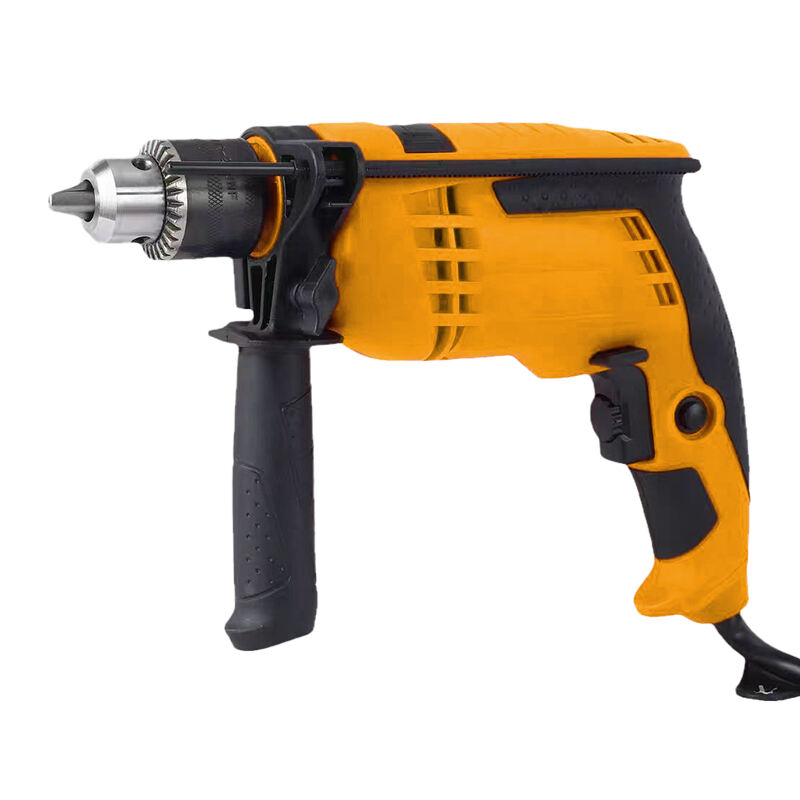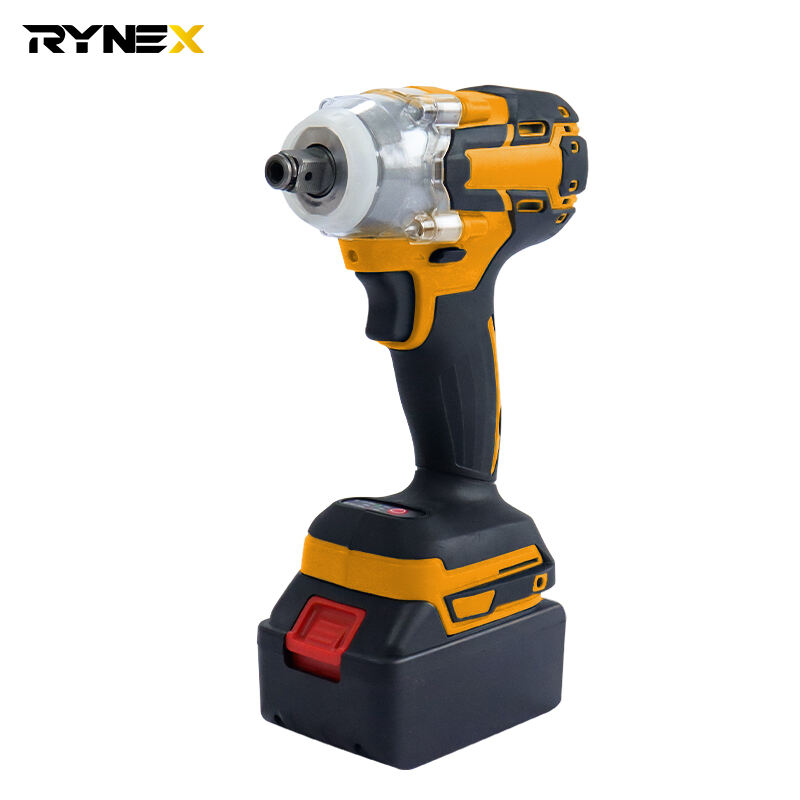Advantages of Cordless Wrenches in Industrial Efficiency
Enhanced Mobility in Confined and Elevated Spaces
Cordless wrenches significantly enhance mobility, particularly in confined or elevated workspaces. Unlike traditional wired tools, cordless wrenches eliminate the restrictions imposed by cords, allowing operators to move freely in tight spaces such as automotive engine compartments or within complex manufacturing equipment. This free movement improves access and productivity, which is vital in industries requiring precision work. For instance, increased mobility can lead to a 20% reduction in time spent on certain tasks, ultimately boosting operational efficiency. This is corroborated by operational studies highlighting mobility as a key factor in reducing job completion time and improving work quality.
Reduction of Operator Fatigue Through Ergonomic Design
One of the prime benefits of cordless wrenches is their ergonomic design, which plays a crucial role in reducing operator fatigue. Many of these tools feature ergonomic grips that are specifically designed to alleviate strain on the hands and wrists, which is especially beneficial during prolonged periods of use. Industry reports indicate that tools with ergonomic designs can lead to a significant 30% decrease in operator fatigue, allowing users to work for longer periods without discomfort. Coupled with their lightweight nature, cordless wrenches contribute to increasing worker satisfaction and efficiency by minimizing the physical toll on operators.
Rapid Fastening Capabilities for Repetitive Tasks
Cordless wrenches are engineered for speed, offering rapid fastening capabilities crucial for completing repetitive tasks efficiently. By allowing operators to fasten and unfasten bolts and nuts swiftly and with minimal effort, these tools enhance workflow in high-volume environments like assembly lines. Studies have shown that rapid fastening can accelerate task completion rates by up to 40% compared to manual alternatives. This feature is particularly advantageous in settings that demand quick turnaround times, such as automotive manufacturing or industrial construction, where efficiency is synonymous with increased productivity and reduced operational costs.
Brushless Motor Technology in Modern Cordless Wrenches
High Torque Output for Heavy-Duty Applications
Brushless motor technology in cordless wrenches offers remarkable high torque output, making it ideal for heavy-duty applications in sectors like construction and automotive repair. These motors often provide torque ratings exceeding 700 Nm, ensuring that even the most challenging fastening tasks are completed with efficiency and precision. Research highlights that brushless motors outperform traditional brushed motors by up to 50% in torque applications, significantly enhancing their appeal for industrial use.
Minimal Maintenance Needs in Rugged Environments
One of the standout benefits of brushless motors is their minimal maintenance requirements, particularly in rugged environments. Unlike brushed motors, which wear out over time, brushless motors are engineered for durability, reducing the need for frequent upkeep. This translates into substantial operational cost savings, with some studies noting a potential reduction in maintenance-related expenses by up to 30%. These motors are well-suited for environments exposed to dust, moisture, and extreme temperatures, where resilience is critical.

Energy Efficiency and Extended Battery Life
Brushless motors excel in energy efficiency, which extends the battery life of cordless tools, making them invaluable for prolonged use. Users can expect around 25% more runtime with batteries powered by brushless technology, an advantage that is crucial in operations where frequent recharging is impractical. The enhanced efficiency ensures that productivity is maintained, providing a seamless working experience in settings where uninterrupted tool use is essential. This energy conservation not only benefits productivity but also aligns with broader environmental goals, making brushless wrenches a wise choice for energy-conscious industries.
Key Industrial Applications Across Sectors
Automotive Assembly Line Optimization
Cordless wrenches are invaluable on automotive assembly lines, primarily for their ability to speed up production processes. By utilizing these tools, assembly lines can enhance their output efficiency by approximately 15%, a statistic backed by numerous studies. The flexibility and mobility offered by cordless wrenches allow workers to quickly switch between tasks, streamlining workflows throughout various stages of manufacturing. This untethered nature not only diminishes downtime but also significantly contributes to the optimization of the production process.
Aerospace Precision Fastening Requirements
In the aerospace industry, precision fastening is of paramount importance, and cordless wrenches equipped with torque control have become instrumental in meeting rigorous safety standards. These wrenches improve assembly accuracy, reducing the risk of accidents or damage associated with improper fastenings. Industry reports highlight that employing advanced cordless wrenches can result in a noticeable decrease in safety incidents during aerospace manufacturing. These tools ensure meticulous attention to detail in fastening processes, thereby safeguarding against potential hazards that could compromise safety and performance.
Large Machinery Maintenance and Modular Toolkits
Cordless wrenches find extensive utility in the maintenance of large machinery, where traditional tools might fall short. Their versatility is further enhanced with the use of torque sockets and extensions, which facilitate tasks such as loosening or tightening fasteners in diverse machinery settings. Expert insights reveal that employing cordless tools for maintenance can boost service response times and improve equipment uptime by an impressive 20%. This efficiency stems from their adaptability, making them a preferred choice in toolkits meant for large machinery upkeep.
Battery Innovations Driving Cordless Tool Adoption
Lithium-Ion Advancements for Continuous Operation
Lithium-Ion technology has revolutionized the battery landscape for cordless tools, offering lighter and longer-lasting energy sources. This advancement is particularly crucial in high-demand industrial environments, where users can experience up to 50% longer use compared to earlier battery technologies like nickel-cadmium (NiCd). The consistent high performance delivered by lithium-ion batteries ensures that tools maintain their efficiency throughout operational cycles. This makes them indispensable for settings where prolonged, uninterrupted operations are necessary.
Fast-Charging Systems Minimizing Downtime
Recent innovations have led to fast-charging systems capable of fully recharging batteries in less than an hour. This ability to quickly recharge is a game-changer in industrial settings, where minimizing downtime is essential to maintaining productivity and profitability. Statistics indicate that companies adopting fast-charging technologies can reclaim approximately 25% of operational time otherwise lost to battery recharges, providing a substantial boost in overall productivity.
Interchangeable Battery Platforms Across Tool Lines
Interchangeable battery platforms have emerged as a convenient and cost-effective innovation, allowing users to use a single battery type across various cordless tools. This system is particularly beneficial in environments necessitating multitasking, as it enhances tool utilization by enabling easy battery switching between devices. According to data from manufacturers, user satisfaction can increase by up to 30% with tools capable of sharing battery packs, highlighting convenience and flexibility as key benefits in modern tool design.
Operational Safety and Workflow Flexibility
Reduced Trip Hazards in Cluttered Workspaces
Cordless tools, such as cordless wrenches, significantly enhance safety by minimizing trip hazards in busy work environments. Without the entanglement of cords, the risk of accidents due to tripping is greatly reduced. This shift contributes to a safer work atmosphere as teams navigate often crowded workshop floors. Safety audits have demonstrated a notable 40% reduction in workplace accidents following the transition to cordless tools. This statistic underscores the substantial impact of adopting modern cordless technology in promoting safer, more efficient workspaces.
Vibration Dampening for Extended Use Safety
Modern cordless wrenches come equipped with advanced vibration-dampening technology that improves user safety during extended use. This innovation lessens the adverse effects of tool vibrations, notably enhancing user comfort and safety. By minimizing exposure to potentially harmful vibrations, these tools reduce the risk of developing conditions such as hand-arm vibration syndrome. Field studies indicate that vibration-dampening tools significantly decrease occurrences of this syndrome, underscoring the critical role of such tools in safeguarding worker health over prolonged periods of tool use.
Adaptability in Multi-Process Manufacturing Environments
Cordless wrenches excel in adaptable, multi-process manufacturing settings, offering exceptional versatility for various tasks. Their flexibility makes them indispensable, enabling a single tool to fulfill multiple roles, thereby minimizing the frequency of tool changes. Insights from manufacturers highlight that the use of adaptable tools can boost productivity by up to 20%, fostering enhanced process optimization. This adaptability not only streamlines operations but also contributes to improved workflow efficiency and effectiveness, making cordless wrenches a valuable asset in dynamic manufacturing environments.
Market Trends Shaping Industrial Tool Selection
Shift Toward Cordless Systems in Maintenance Operations
Industrial tool selection is increasingly influenced by the shift towards cordless systems in maintenance operations. This trend is driven by the superior ease of use and enhanced efficiency these tools offer. Adopting cordless technology has proven beneficial for companies, as it significantly speeds up maintenance tasks and improves overall effectiveness. According to market research, cordless tools are poised to lead the charge in industrial settings as businesses pursue greater flexibility and operational efficiency. This shift is not only about convenience but also about embracing technological advancements to streamline workflows.
Sustainability Demands Influencing Tool Design
Sustainability is playing a pivotal role in the transformation of tool design and manufacturing. There is a growing movement towards the use of eco-friendly materials, pushing manufacturers to rethink the traditional design approach. Emphasizing the development of maintenance-free, reusable tools supports more sustainable business models and aligns with global environmental goals. Surveys reveal that more than 60% of manufacturers now prioritize sustainability during the product selection process. This trend signifies a shift towards greener practices in the industry, encouraging companies to innovate responsibly.
Integration with IoT for Performance Monitoring
The integration of Internet of Things (IoT) technology into cordless tools is revolutionizing performance monitoring. IoT capabilities provide real-time insights, enabling predictive maintenance and usage tracking, which are reshaping operational strategies. Reports suggest that up to 70% of companies integrating IoT technology notice improvements in tool performance and a reduction in maintenance costs. This technological advancement parallels the broader movement towards smart manufacturing and industry automation, offering an exciting horizon for industrial tool selection. Through IoT, businesses can optimize tool usage, anticipate issues, and improve efficiency, solidifying their position in the evolving industrial landscape.
FAQs About Cordless Wrenches
What are the benefits of using cordless wrenches?
Cordless wrenches offer enhanced mobility, reduced operator fatigue, rapid fastening capabilities, high torque output, minimal maintenance needs, and energy efficiency which together improve industrial efficiency in various sectors.
How do brushless motors contribute to the efficiency of cordless wrenches?
Brushless motors provide higher torque output, require less maintenance, and offer greater energy efficiency leading to extended battery life, making them ideal for heavy-duty applications and improving overall operational efficiency.
What industries benefit the most from cordless wrench technology?
Cordless wrenches benefit industries such as automotive manufacturing, aerospace, construction, and large machinery maintenance by optimizing assembly line processes, ensuring precision fastening, and enhancing maintenance operations.
How do advancements in battery technology impact cordless wrench usage?
Lithium-ion advancements provide lighter, longer-lasting batteries with fast-charging capabilities and interchangeable battery platforms that minimize downtime and maximize tool usage across various devices, crucial for continuous operations.
Table of Contents
- Advantages of Cordless Wrenches in Industrial Efficiency
- Brushless Motor Technology in Modern Cordless Wrenches
- Key Industrial Applications Across Sectors
- Battery Innovations Driving Cordless Tool Adoption
- Operational Safety and Workflow Flexibility
- Market Trends Shaping Industrial Tool Selection
- FAQs About Cordless Wrenches

